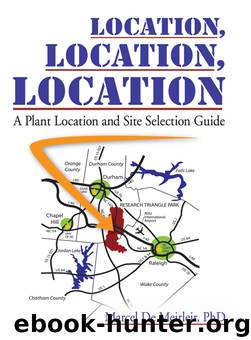Location, Location, Location by Marcel De Meirleir

Author:Marcel De Meirleir
Language: eng
Format: epub
Publisher: Routledge
Water and Waste
Water and waste have always been high on the list of determining factors in selecting a plant location, particularly in the chemical and pharmaceutical industries, but also in such large plants as automotive assembly lines. However, with the increased influence of the Green political party, legislation, requirements, and cost have increased dramatically over the past two decades.
The most difficult projects we have dealt with in terms of water and waste were in Italy for an antibiotics plant and in the United States for an artificial sweetener plant. Both projects needed massive and steady amounts of pure water. The first plant had a deoxidized stream, which smelled very badly. The second produced a large amount of wastewater that was very expensive and difficult to treat.
In the case of the Italian plant, the geographical pattern of the region and the all-important agricultural union were used to determine location. Many irrigation canals south of Naples were dredged during the early years of the Mussolini regime to be used for soldiers in the Pontini marches that settled people from the north. Those living in the canal region became victims of the inundations, and in many cases lost their homes and belongings. As a result of the dredge, the region became an uninhabited yet fertile agricultural area with high-yield crops. When a hydraulic study indicated the presence of large quantities of clear water from the Apennines, the only drawback was the cost of treating deoxidized water that had a bad smell.
Discussions with agricultural lobbies led to an agreement to use the wastewater as irrigation water and to pump that water onto the land. The results were spectacular. On the negative side of this action, the area could be spotted from a long distance because of the foul smell, particularly in the hot summers. On the positive side, the wastewater acted as a fertilizer, which increased the crop yield substantially.
Some time later, a treatment plant was built and the previous system was taken out of service because of ecological legislation.
Download
This site does not store any files on its server. We only index and link to content provided by other sites. Please contact the content providers to delete copyright contents if any and email us, we'll remove relevant links or contents immediately.
Hit Refresh by Satya Nadella(9083)
The Compound Effect by Darren Hardy(8872)
Change Your Questions, Change Your Life by Marilee Adams(7686)
Nudge - Improving Decisions about Health, Wealth, and Happiness by Thaler Sunstein(7659)
The Black Swan by Nassim Nicholas Taleb(7058)
Deep Work by Cal Newport(6966)
Rich Dad Poor Dad by Robert T. Kiyosaki(6514)
Daring Greatly by Brene Brown(6474)
Principles: Life and Work by Ray Dalio(6296)
Playing to Win_ How Strategy Really Works by A.G. Lafley & Roger L. Martin(6084)
Man-made Catastrophes and Risk Information Concealment by Dmitry Chernov & Didier Sornette(5957)
Digital Minimalism by Cal Newport;(5704)
Big Magic: Creative Living Beyond Fear by Elizabeth Gilbert(5679)
The Myth of the Strong Leader by Archie Brown(5458)
The Slight Edge by Jeff Olson(5376)
Discipline Equals Freedom by Jocko Willink(5336)
The Motivation Myth by Jeff Haden(5175)
The Laws of Human Nature by Robert Greene(5081)
Stone's Rules by Roger Stone(5052)
